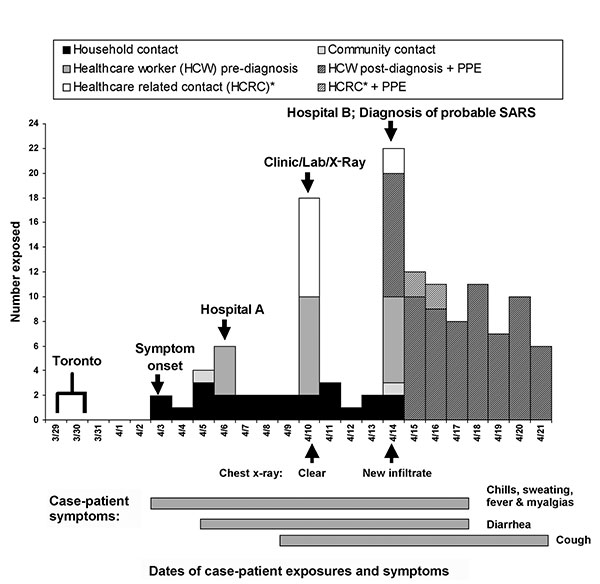Volume 10, Number 2—February 2004
THEME ISSUE
2004 SARS Edition
SARS Transmission
Lack of SARS Transmission and U.S. SARS Case-Patient
Figure 1

Figure 1. Timeline: severe acute respiratory syndrome (SARS) case-patient symptoms and total daily number of contacts from date of symptom onset to date of hospital discharge. Contacts indicated regardless of their subsequent participation in this investigation. Close contact was defined as any contact within 3 feet or contact within 3 to 10 feet for an extended duration (two persons). Repeated contacts by the same person over successive days are shown as independent events. *Healthcare-related contact refers to non–healthcare worker (HCW) contacts in a healthcare setting (persons in waiting rooms of physician office and referral laboratory, curtained area in the emergency department, and two persons who reportedly used personal protective equipment (PPE) and visited the case-patient in his hospital room on 4/15 and 4/16.
1Members of the Pennsylvania SARS Investigation Team: Marc-Alain Widdowson, Nino Khetsuriani, L. Clifford McDonald, Stephan S. Monroe, Suxiang Tong, James A. Comer, Daniel Jernigan, Matthew J. Kuehnert, Joseph S. Bresee, Sara A. Lowther, and Larry J. Anderson (CDC); Mary Theresa Temarantz, John P. Bart, William S. Miller, Mary Jo Lampart, and Carol Yozviak (Pennsylvania Department of Health); Shana Stites, (Bethlehem Bureau of Health); Susan Oliver, Debra Wilson, Carol Guanowsky, and Beverly Wasko (Lehigh Valley Hospital); Corwin A. Roberston (CDC and New Jersey Department of Health and Senior Services); and Diane Krolikowski, Jeff Bomboy, and Reynaldo C. Guerra.